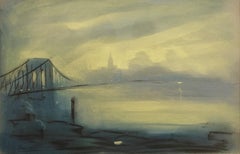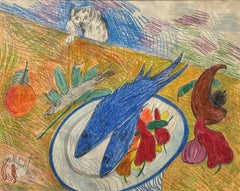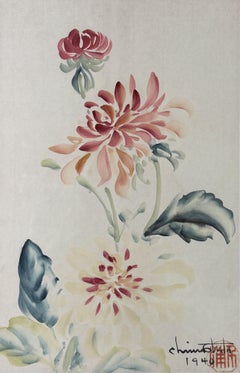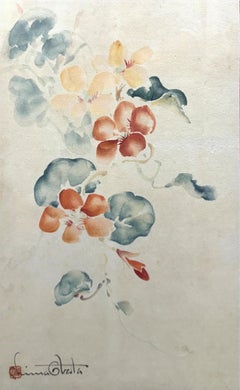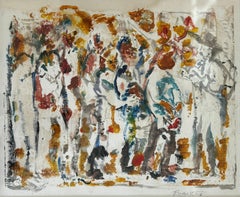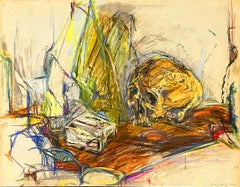Lincoln Glenn Figurative Drawings and Watercolors
to
7
11
16
6
3
Overall Width
to
Overall Height
to
2
34
1
2
13
3
4
2
2
2
20
2
2
2
1
1
1
21
14
1
20
12
8
8
6
6
5
5
5
4
4
4
4
3
3
2
2
2
2
1
36
17
17
15
13
11
2
2
2
2
24
10
36
"New York Harbor (Brooklyn Bridge)" Leon Dolice, Mid-Century New York Nocturne
By Leon Dolice
Located in New York, NY
Leon Dolice
New York Harbor (Brooklyn Bridge), circa 1939-1940
Signed lower left
Pastel on paper
12 x 19 inches
Exhibited
Roslyn Harbor, New York, Nassau County Museum of Art, Deco ...
Category
1930s American Modern Figurative Drawings and Watercolors
Materials
Paper, Pastel
"Fish and Cat" Jimmy Tsutomu Mirikitani, Vibrant, Colorful, Japanese-American
Located in New York, NY
Jimmy Tsutomu Mirikitani
Fish and Cat, 1998
Signed and dated lower left
Crayon on paper
Sight 17 x 23 inches
When Jimmy Tsutomu Mirikitani, a native of California, returned to the ...
Category
1990s American Modern Animal Drawings and Watercolors
Materials
Paper, Crayon
"Dahlias" Chiura Obata, Japanese American, Red and Blue Delicate Floral Work
By Chiura Obata
Located in New York, NY
Chiura Obata
Dahlias, 1940
Signed, dated and stamped lower right
Watercolor on paper
15 x 9 5/8 inches
Born in the Okayama prefecture of Japan, Chiura Obata was adopted by his uncle, an artist. As a child he was trained in ink painting, and at 14 he was apprenticed to the painter Murata Tanryo in Tokyo. He also studied with Kogyo Terasaki and Goho Hasimoto.
In 1903, Obata moved to San Francisco and began working as an illustrator for The New World and The Japanese American, two of the city's Japanese newspapers. He also did work as a commercial designer. Obata helped establish the East West Art Society in San Francisco in 1921, which sought to promote cross-cultural understanding through art. This goal was reflected in his embrace of the Nihonga style, which fused traditional Japanese sumi-e ink painting with the conventions of western naturalism.
He spent much of the 1920s painting landscapes throughout California, and among his favorite subjects were mountain landscapes. In 1927, he visited Yosemite and the Sierra Nevada, creating over a hundred paintings and sketches of the high country. Obata stayed in the USA until the death of his father in 1928.
Between 1928 and 1932, he worked in Tokyo as a painter and transformed his California landscape watercolors...
Category
1940s Modern Still-life Drawings and Watercolors
Materials
Paper, Watercolor
"Nasturtiums" Chiura Obata, Japanese American, Red and Blue Delicate Flowers
By Chiura Obata
Located in New York, NY
Chiura Obata
Nasturtiums, circa 1940
Signed and stamped lower left
Watercolor on paper
15 x 9 5/8 inches
Born in the Okayama prefecture of Japan, Chiura Obata was adopted by his uncle, an artist. As a child he was trained in ink painting, and at 14 he was apprenticed to the painter Murata Tanryo in Tokyo. He also studied with Kogyo Terasaki and Goho Hasimoto.
In 1903, Obata moved to San Francisco and began working as an illustrator for The New World and The Japanese American, two of the city's Japanese newspapers. He also did work as a commercial designer. Obata helped establish the East West Art Society in San Francisco in 1921, which sought to promote cross-cultural understanding through art. This goal was reflected in his embrace of the Nihonga style, which fused traditional Japanese sumi-e ink painting with the conventions of western naturalism.
He spent much of the 1920s painting landscapes throughout California, and among his favorite subjects were mountain landscapes. In 1927, he visited Yosemite and the Sierra Nevada, creating over a hundred paintings and sketches of the high country. Obata stayed in the USA until the death of his father in 1928.
Between 1928 and 1932, he worked in Tokyo as a painter and transformed his California landscape watercolors...
Category
1940s Modern Still-life Drawings and Watercolors
Materials
Paper, Watercolor
"The Gathering" Theresa Bernstein, Abstracted Figures Ashcan School Artist
By Theresa Bernstein
Located in New York, NY
Theresa Bernstein
The Gathering, circa 1990
Signed lower right
Mixed media on paper
9 x 10 3/4 inches
Theresa F. Bernstein was born in Philadelphia in 1895 to cultured, middle-clas...
Category
1990s Abstract Abstract Drawings and Watercolors
Materials
Paper, Mixed Media
"Still Life" Diana Kurz, Expressionist Still Life With Skull Pastel on Paper
By Diana Kurz
Located in New York, NY
Diana Kurz
Still Life, 1966
Signed and dated lower right
Pastel on paper
19 3/4 x 25 1/2 inches
Diana Kurz (born 1936) is an Austrian-born feminist painter. In 1938, Diana Kurz's f...
Category
1960s Abstract Expressionist Abstract Drawings and Watercolors
Materials
Paper, Pastel
"Tropical Flower with Azalea" Joseph Stella, circa 1919 Academic Azalea
By Joseph Stella
Located in New York, NY
Joseph Stella
Tropical Flower with Azalea, circa 1919
Signed lower right
Silverpoint and crayon on paper
Image 10 3/4 x 8 1/4 inches
Sheet 11 x 12 1/4 inches
Stella was born June 1...
Category
Early 20th Century Modern Figurative Drawings and Watercolors
Materials
Paper, Watercolor
"Flowers" Joseph Stella, Vibrant Modernist Flower Composition on Paper
By Joseph Stella
Located in New York, NY
Joseph Stella
Flowers
Signed lower center
Crayon and pencil on paper
13 1/4 x 10 1/4 inches
Stella was born June 13, 1877 at Muro Lucano, Italy, a mountain village not far from Nap...
Category
Early 20th Century Modern Figurative Drawings and Watercolors
Materials
Paper, Crayon, Pencil
"Tree at the Edge of the Field, Springs" Nell Blaine, 1967 Abstracted Landscape
By Nell Blaine
Located in New York, NY
Nell Blaine
Tree at the Edge of the Field, Springs, 1967
Signed and dated lower left
Watercolor on paper
14 1/2 x 20 inches
Nell Blaine was born in Richmond, Virginia in 1922. She ...
Category
1960s Modern Figurative Drawings and Watercolors
Materials
Paper, Watercolor
"Animal Illustrations" Allan Rohan Crite, 2 Ink Drawings African American Artist
Located in New York, NY
Allan Rohan Crite
Animal Illustrations
Signed lower left
Pen and ink on paper
23 1/2 x 16 inches
Brought up in Boston, Crite received his art training al the School of the Museum of Fine Arts and earned a Bachelor of Arts degree at the Harvard University Extension School in 1968. He worked for most of his life as an illustrator in the Planning Department of the Boston Naval Shipyards, retiring in 1976, but continued to paint at the same time. His work has been widely exhibited and well received in Boston, where a square is named after him. Crite's early paintings depict the daily life of Boston's African-American community, a community that was to be transformed in the following decade by urban renewal and housing projects.
In his later paintings, magic-realist visions in which a black Virgin and Child ride on public transportation or float above the city streets, Crite used a bright palette rather than the more somber tones of his "neighborhood paintings...
Category
1930s Surrealist Animal Drawings and Watercolors
Materials
Paper, Ink
"New York Harbor Nocturne" Leon Dolice, Mid-Century New York Nocturnal Landscape
By Leon Dolice
Located in New York, NY
Leon Dolice
New York Harbor Nocturne
Signed lower right
Pastel on paper
12 x 19 inches
The romantic backdrop of Vienna at the turn of the century had a life-long influence upon the...
Category
1930s American Modern Figurative Drawings and Watercolors
Materials
Paper, Pastel
"New York Harbor Nocturne" Leon Dolice, Mid-Century New York Nocturnal Landscape
By Leon Dolice
Located in New York, NY
Leon Dolice
New York Harbor Nocturne, circa 1930-40
Signed lower right
Pastel on paper
12 x 19 inches
The romantic backdrop of Vienna at the turn of the century had a life-long inf...
Category
1930s American Modern Figurative Drawings and Watercolors
Materials
Paper, Pastel
"New York Harbor Nocturne" Leon Dolice, Mid-Century New York Nocturnal Landscape
By Leon Dolice
Located in New York, NY
Leon Dolice
New York Harbor Nocturne
Signed lower right
Pastel on paper
12 x 19 inches
The romantic backdrop of Vienna at the turn of the century had a life-long influence upon the...
Category
1930s American Modern Landscape Drawings and Watercolors
Materials
Paper, Pastel
"New York Harbor Nocturne" Leon Dolice, Mid-Century New York Nocturnal Landscape
By Leon Dolice
Located in New York, NY
Leon Dolice
New York Harbor Nocturne
Signed lower right
Pastel on paper
12 x 19 inches
The romantic backdrop of Vienna at the turn of the century had a life-long influence upon the...
Category
1930s American Modern Figurative Drawings and Watercolors
Materials
Paper, Pastel
"New York Harbor Nocturne" Leon Dolice, Mid-Century New York Nocturnal Landscape
By Leon Dolice
Located in New York, NY
Leon Dolice
New York Harbor Nocturne
Signed lower right
Pastel on paper
12 x 19 inches
The romantic backdrop of Vienna at the turn of the century had a life-long influence upon the...
Category
1930s American Modern Figurative Drawings and Watercolors
Materials
Paper, Pastel
"New York Harbor Nocturne" Leon Dolice, New York Scene, Mid-Century Landscape
By Leon Dolice
Located in New York, NY
Leon Dolice
New York Harbor Nocturne
Signed lower right
Pastel on paper
12 x 19 inches
The romantic backdrop of Vienna at the turn of the century had a life-long influence upon the...
Category
1930s Figurative Drawings and Watercolors
Materials
Paper, Pastel
"New York Harbor Nocturne" Leon Dolice, New York Harbor Scene Mid-Century
By Leon Dolice
Located in New York, NY
Leon Dolice
New York Harbor Nocturne
Signed lower right
Pastel on paper
12 x 19 inches
The romantic backdrop of Vienna at the turn of the century had a life-long influence upon the...
Category
1930s American Modern Figurative Drawings and Watercolors
Materials
Paper, Pastel
"Empire State Building" Leon Dolice, New York City Street Scene, Mid-Century
By Leon Dolice
Located in New York, NY
Leon Dolice
Empire State Building
Signed lower right
Watercolor on paper
19 x 12 inches
The romantic backdrop of Vienna at the turn of the century had a life-long influence upon th...
Category
1930s American Modern Figurative Drawings and Watercolors
Materials
Paper, Pastel
"Central Park" Leon Dolice, New York Central Park Scene, Mid-Century
By Leon Dolice
Located in New York, NY
Leon Dolice
Central Park
Signed lower left
Watercolor on paper
12 x 19 inches
The romantic backdrop of Vienna at the turn of the century had a life-long influence upon the young ma...
Category
1930s American Modern Figurative Drawings and Watercolors
Materials
Paper, Pastel
$2,400 Sale Price
20% Off
"Chrysler Building" Leon Dolice, New York City Street Scene, Mid-Century
By Leon Dolice
Located in New York, NY
Leon Dolice
Chrysler Building
Signed lower right
Watercolor on paper
19 x 12 inches
The romantic backdrop of Vienna at the turn of the century had a life-long influence upon the yo...
Category
1930s American Modern Figurative Drawings and Watercolors
Materials
Pastel, Paper
"Suburb of Gif-sur-Yvette, France" Henry Yuzuru Sugimoto, Modernist Landscape
Located in New York, NY
Henry Yuzuru Sugimoto
Suburb of Gif-sur-Yvette, France, circa 1928-32
Signed lower left
Watercolor on paper
11 x 14 inches
Henry Sugimoto was born in Wakayama, Japan, on March 12, 1900. His father left for the United States shortly after he was born, and his mother joined him some years later, with the result that the young Henry was raised largely by his grandparents. Following the end of World War I, Henry Sugimoto arrived in the United States as a "yobiyose" (child brought over) and settled with his parents in Hanford, California. After attending Hanford High School, he enrolled at the University of California, Berkeley. He soon grew absorbed in art and his parents agreed to let him enroll at the California School of Arts and Crafts. After studying there for four years with a concentration in oil painting, he graduated with honors in 1928. He then moved to the California School for Fine Arts, but after a year there he decided to travel to France, the international artistic capital, for further study. Once arrived in Paris, Sugimoto became close to the circle of Japanese...
Category
1930s Modern Figurative Drawings and Watercolors
Materials
Paper, Watercolor
"Families near Seville, Spain" Martha Walter, Modernist Figures in Landscape
By Martha Walter
Located in New York, NY
Martha Walter
Families near Seville, Spain
Signed lower left
Watercolor on paper
7 x 8 inches
Martha Walter was best known as a painter of colorful beach scenes and landscapes. Inf...
Category
Early 20th Century American Modern Figurative Drawings and Watercolors
Materials
Paper, Watercolor
"Mothers and Children, North Africa" Martha Walter, Impressionist Watercolor
By Martha Walter
Located in New York, NY
Martha Walter
Mothers and Children, North Africa
Signed lower right
Watercolor on paper
6 1/2 x 7 1/2 inches
Martha Walter was best known as a painter of colorful beach scenes and ...
Category
Early 20th Century American Impressionist Figurative Paintings
Materials
Paper, Watercolor
"Musical Conductor" Amy Londoner, Ashcan School, Figurative Concert Scene
By Amy Londoner
Located in New York, NY
Amy Londoner
Musical Conductor, 1922
Signed and dated lower right
Pastel on paper
Sight 18 x 23 inches
Amy Londoner (April 12, 1875 – 1951) was an American painter who exhibited at the 1913 Armory Show. One of the first students of the Henri School of Art in 1909. Prior to the Armory Show of 1913, Amy Londoner and her classmates studied with "Ashcan" painter Robert Henri at the Henri School of Art in New York, N.Y. One notable oil painting, 'The Vase', was painted by both Henri and Londoner.
Londoner was born in Lexington, Missouri on April 12, 1875. Her parents were Moses and Rebecca Londoner, who moved to Leadville, Colorado, by 1880. In 1899, Amy took responsibility for her father who had come to Los Angeles from Leadville and had mental issues. By 1900, Amy was living with her parents and sister, Blanche, in the vicinity of Leadville, Denver, Colorado. While little was written about her early life, Denver City directories indicated that nineteenth-century members of the family were merchants, with family ties to New York, N.Y. The family had a male servant. Londoner traveled with her mother to England in 1907 then shortly later, both returned to New York in 1909. Londoner was 34 years old at the time, and, according to standards of the day, should have married and raised a family long before. Instead, she enrolled as one of the first students at the Henri School of Art in 1909.
At the Henri School, Londoner established friendships with Carl Sprinchorn (1887-1971), a young Swedish immigrant, and Edith Reynolds (1883-1964), daughter of wealthy industrialist family from Wilkes-Barre, PA. Londoner's correspondence, which often included references to Blanche, listed the sisters' primary address as the Hotel Endicott at 81st Street and Columbus Avenue, NYC. Other correspondence also reached Londoner in the city via Mrs. Theodore Bernstein at 252 West 74th Street; 102 West 73rd Street; and the Independent School of Art at 1947 Broadway. In 1911, Londoner vacationed at the Hotel Trexler in Atlantic City, NJ. As indicated by an undated photograph, Londoner also spent time with Edith Reynolds and Robert Henri at 'The Pines', the Reynolds family estate in Bear Creek, PA.
Through her connections with the Henri School, Londoner entered progressive social and professional circles. Henri's admonition, phrased in the vocabulary of his historical time period, that one must become a "man" first and an artist second, attracted both male and female students to classes where development of unique personal styles, tailored to convey individual insights and experiences, was prized above the mastery of standardized, technical skill. Far from being dilettantes, women students at the Henri School were daring individuals willing to challenge tradition. As noted by former student Helen Appleton Read, "it was a mark of defiance,to join the radical Henri group."
As Henri offered educational alternatives for women artists, he initiated exhibition opportunities for them as well. Troubled by the exclusion of work by younger artists from annual exhibitions at the National Academy of Design, Henri was instrumental in organizing the no-jury, no-prize Exhibition of Independent Artists in 1910. About half of the 103 artists included in the exhibition were or had been Henri students, while twenty of the twenty-six women exhibiting had studied with Henri. Among the exhibition's 631 pieces, nine were by Amy Londoner, including the notorious 'Lady with a Headache'. Similarly, fourteen of Henri's women students exhibited in the groundbreaking Armory Show of 1913, forming about eight percent of the American exhibitors and one-third of American women exhibitors. Of the nine documented works submitted by Londoner, five were rejected, while four pastels of Atlantic City beach scenes, including 'The Beach Umbrellas' now in the Remington Collection, were displayed.
Following Henri's example, Londoner served as an art instructor for younger students at the Modern School, whose only requirement was to genuinely draw what they pleased. The work of dancer Isadora Duncan, another artist devoted to the ideals of a liberal education, was also lauded by the Modern School. Henri, who long admired Duncan and invited members of her troupe to model for his classes, wrote an appreciation of her for the Modern School journal in 1915. She was also the subject of Londoner's pastel Isadora Duncan and the Children: Praise Ye the Lord with Dance. In 1914, Londoner traveled to France to spend summer abroad, living at 99 rue Notre Dames des Champs, Paris, France. As the tenets of European modernism spread throughout the United States, Londoner showed regularly at venues which a new generation of artists considered increasingly passe, including the annual Society of Independent Artists' exhibitions between 1918 and 1934, and the Salons of America exhibition in 1922. Londoner also exhibited at the Morton Gallery, Opportunity Gallery, Leonard Clayton Gallery and Brownell-Lambertson Galleries in NYC. Her painting of a 'Blond Girl' was one of two works included in the College Art Associations Traveling Exhibition of 1929, which toured colleges across the country to broad acclaim.
Londoner later in life suffered from illnesses then suffered a stroke which resulted in medical bills significantly mounting over the years that her old friends from the Henri School, including Carl Sprinchorn, Florence Dreyfous, Florence Barley, and Josephine Nivison Hopper, scrambled to raise funds and find suitable long-term care facilities for Londoner. Londoner later joined Reynolds in Bear Creek, PA. Always known for her keen wit, Londoner retained her humor and concern for her works even during her illness, noting that "if anything happens to the Endicott, I guess they will just throw them out." Sprinchorn and Reynolds, however, did not allow this to happen. In 1960, Londoner's paintings 'Amsterdam Avenue at 74th Street' and 'The Builders' were loaned by Reynolds to a show commemorating the Fiftieth Anniversary of the Exhibition of Independent Artists in 1910, presented at the Delaware Art Center, Wilmington, DE. In the late 80's, Francis William Remington, 'Bill Remington', of Bear Creek Village PA, along with his neighbor and artist Frances Anstett Brennan, both had profound admiration for Amy Londoner's art work and accomplishments as a woman who played a significant role in the Ashcan movement. Remington acquired a significant number of Londoner's artwork along with Frances Anstett Brenan that later was part of an exhibition of Londoner's artwork in April 15 of 2007, at the Hope Horn...
Category
1920s Ashcan School Figurative Paintings
Materials
Paper, Pastel
"In Foreign Parts" Eugene Higgins, Southwestern Pueblo, Modern Figurative
By Eugene Higgins
Located in New York, NY
Eugene Higgins
In Foreign Parts, circa 1913
Signed lower right
Watercolor on paper
Sight 17 x 13 inches
Born William Victor Higgins in 1884 to a Shelbyville, Indiana farm family where the only art Victor was aware of as a child was his father's love of flowers. "He loved their forms and their colors, and he tended his garden as a painter might work a canvas." At the age of nine, Victor met a young artist who traveled the Indiana countryside painting advertisements on the sides of barns. He purchased paints and brushes so the young Higgins could practice his own artwork on the inside of his father's barn. He also taught Victor about art museums and especially about the new Chicago Art Institute. This information never left the young artist, and he saved his allowance until his father allowed him at the age of fifteen to attend Chicago Art Institute. He worked a variety of jobs to finance his studies both there and at the Academy of Fine Arts.
Victor Higgins traveled to New York in 1908, where he met Robert Henri, who became a significant influence by depicting every-day scenes and stressing the importance of the spirit and sense of place as important factors in painting. Higgins was also greatly affected by the New York Armory Modernism Show of Marsden Hartley in 1913.
While Victor Higgins was in Chicago he met former mayor and avid collector Carter H. Harrison who was to prove instrumental in the growth of Higgins career for several years. Harrison agreed to support Higgins for four years to go to Paris and Munich and paint and study in the great museums in Europe. While at the Academie de la Grande Chaumier in Paris (1910-1914) he met Walter Ufer, who was another Chicago artist being sponsored by Carter Harrison. This meeting was not only a life-long friendship, but the beginning of a great change in the way Higgins looked at "American" art. He decided that America needed it's own authentic style rather than the 19th Century classic style he was taught in Europe. Very soon after returning to Chicago in 1914, Harrison sent him and Walter Ufer on a painting trip to Taos, New Mexico for a year in exchange for paintings. Higgins made other similar agreements and was able to support himself with his painting. This trip was a life-changing experience and introduced Higgins to the authentic America he had been looking for.
In 1914 Taos was an isolated village about twelve hours from Santa Fe on an impossible dirt road. But the colorful life of the pueblo people and the natural beauty drew a collection of artists who became the Taos art colony, from which the Taos Society of Artists was founded in 1915. Victor Higgins became a permanent resident within a year of his arrival and a member of the society in 1917, exhibiting with Jane Peterson in 1925 and with Wayman Adams and Janet Scudder in 1927. The members would travel around the country introducing the Southwest scenes with great success. He remained a member until the Society's dissolution in 1927. Higgins was the youngest member of the group of seven. Other members were Joseph Henry Sharp, Bert Phillips...
Category
1910s American Modern Figurative Drawings and Watercolors
Materials
Paper, Watercolor
"Untitled" Bob Thompson, Figurative Work on Paper, Black Abstract Artist
By Bob Thompson
Located in New York, NY
Bob Thompson
Untitled, 1964
Felt tip pen on printed paper
11 x 20 1/2 inches
Provenance:
The artist
Kathy Komaroff Goodman (gift from the artist)
Hollis Taggart, New York
Exhibited...
Category
1960s Modern Figurative Drawings and Watercolors
Materials
Paper, Watercolor
"Young Girl (Jenue Fille)" Louis Valtat, French Drawing
By Louis Valtat
Located in New York, NY
Louis Valtat
Young Girl
Stamped with initials lower right
Pencil on brown paper
Sight 7 x 6 inches
Provenance:
Mrs. Ernest M. Werner, New York
Private Collection, Rhode Island
Loui...
Category
Early 20th Century Fauvist Figurative Drawings and Watercolors
Materials
Paper, Pencil
$2,000 Sale Price
20% Off
"Untitled, " Crash, Pop Art, Street Art Graffiti, Figure with Clock
By John Crash Matos
Located in New York, NY
Crash
Untitled, 1989
Signed and dated lower left
Watercolor and ink on paper
30 x 20 1/2 inches
A contemporary of Keith Haring and a modern-day master of this present day art form o...
Category
1980s Street Art Figurative Paintings
Materials
Paper, Ink, Watercolor
"Pleased to See You, " Crash, Pop Art, Street Art Graffiti
By John Crash Matos
Located in New York, NY
Crash
Pleased to See You, 1989
Signed and dated lower left
Watercolor and ink on paper
30 x 20 1/2 inches
A contemporary of Keith Haring and a modern-day master of this present day ...
Category
1980s Street Art Figurative Paintings
Materials
Paper, Ink, Watercolor
Out of the Sun (Under the Racetrack Grandstand), Saratoga Springs, Anne Diggory
By Anne Diggory
Located in New York, NY
Anne Diggory (b. 1951)
Out of the Sun (Under the Racetrack Grandstand), 1978
Watercolor on paper
7 x 10 inches
Signed and dated lower left
Provenance:
Ac...
Category
1970s Contemporary Landscape Drawings and Watercolors
Materials
Paper, Watercolor, Pencil
"Figures, " Melecio Galvan, Modern Mexican Anti-War Artist, Social Justice
Located in New York, NY
Melecio Galvan (1945 - 1982)
Figures, 1968
Sepia on paper
18 x 22 inches
Signed and dated lower right
Provenance:
Estate of the artist
Melecio Galván (San Rafael, Mexico, 1945 - 1982) was a Mexican draughtsman who was little-known during his lifetime. This is principally because he was a socio-politically committed artist wary of the commercial gallery circuit as well as art institutions controlled by the state. He arose from a working-class family in San Rafael, on the outskirts of Mexico City, and died under mysterious circumstances in that town at the age of 37, just when he was reaching the apogee of his mature style. Galván studied at the Academia San Carlos in Mexico City between 1965 and 1968. His preferred medium was ink on paper, and he created page upon page of sketchbooks filled with drawings. The major themes he developed in his work were reinterpretations of classical drawings of the human figure and anatomy studies, explorations of the grotesque, and themes related to the socio-political situation in Mexico, especially following the 1968 Tlateloco Massacre. In 1971-72, he traveled to Northern California where he collaborated on a mural in Fresno and created illustrations for the Latino journal Basta Ya (Enough Already) in San Francisco. Back in Mexico City, from 1977 to 1981 he was a member of the Grupo MIRA, primarily comprised of printmakers who favored themes of politics and social justice...
Category
1960s Figurative Drawings and Watercolors
Materials
Paper, Pigment
"Portrait of an Italian Fencer, " John Frederick Kensett, Hudson River School
By John Frederick Kensett
Located in New York, NY
John Frederick Kensett (1816 - 1872)
Portrait of an Italian Fencer, circa 1845-47
Watercolor on wove paper
13 1/8 x 8 1/8 inches
Signed with initials and inscribed lower right "J.F.K. Rome"
From October 1845 through the spring of 1847, Kensett lived in Rome. He attended classes where he sketched from live models, and he sketched in the countryside outside Rome and around Florence, Perugia, and Venice, places he visited with his artist friends. He fulfilled commissions for paintings from Americans in Italy, and by 1847 his career was well established.
Son of an English immigrant engraver, John Kensett lacked enthusiasm for that medium and became one of the most accomplished painters of the second generation of Hudson River School painters. His reputation is for Luminism, careful depiction of light, weather, and atmosphere as they affect color and texture of natural forms. He was particularly influenced by the painting of Asher Durand in that he focused on realism and detail rather than the highly dramatic views associated with Thomas Cole. Going to the western United States in the mid 1850s and the 1860s, he was the first of the Hudson River School painters to explore and paint the West.
Kensett was born and raised in Cheshire, Connecticut, and learned his engraving from his father, Thomas Kensett with whom he worked in New Haven, Connecticut until 1829. He continued working until 1840 as an engraver of labels, banknotes and maps and was employed part of that time by the American Bank Note Company in New York City. There he met Thomas Rossiter, John Casilear, and other artists who urged him to pursue painting. In 1840, he and Rossiter, Asher Durand, and Casilear went to Europe where Kensett stayed for seven years and supported himself by doing engraving but became accomplished in landscape painting.
Having sent canvases of Italian landscapes back to New York, he had a reputation for skillful painting that preceded him. When he returned to New York City in 1847, he was an "instant success" and very sought after by collectors. Two of his Italian landscapes had already been purchased by the American Art Union. By 1849, he was a full member of the National Academy of Design and was generally popular among his peers. His studio was a gathering place with travelers stopping by to see his canvases and to identify "precise locations in the Catskills or Newport or New England in the oil sketches and drawings that covered his walls." (Zellman 170). For the women, he was a popular bachelor, "romantic looking with high forehead and sensitive expression." (Samuels 262)
He was also sought after by many organizations. Among his activities were serving on the committee to oversee the decoration of the United States Capitol in Washington DC, and becoming one of the founders of the Metropolitan Museum in New York.
An inveterate traveler, Kensett spent summers on painting excursions away from New York City. One of these trips was a special painting excursion with fifteen other artists sponsored by the B & O Railroad from Baltimore, Maryland to Wheeling, West Virginia. Unlike many of the Hudson River painters...
Category
1840s Hudson River School Figurative Paintings
Materials
Paper, Watercolor
"A Martinique Native in French Guyana, " Black Female Portrait, Female Artist
Located in New York, NY
May Mott Smith (1879 - 1952)
A Martinique Native in French Guiana, circa 1925
Watercolor on paper
24 x 20 inches
Signed lower right; titled on the reverse
“Martinique Native” is an ...
Category
1920s Feminist Portrait Drawings and Watercolors
Materials
Paper, Watercolor
"Medieval Thoughts, Prague, " Alphonse Mucha, Czech Art Nouveau Illustration
By Alphonse Mucha
Located in New York, NY
Alphonse Mucha (Czech, 1860 - 1939)
Medieval Thoughts, circa 1890
Wash, ink, and watercolor on paper
11 x 9 inches
Signed lower right
Provenance:
Phillips New York, 19th and 20th ce...
Category
1890s Art Nouveau Figurative Drawings and Watercolors
Materials
Paper, Ink, Watercolor
"Lobstermen in Gloucester, Mass." Lionel Reiss WPA Social Realism Fishermen
By Lionel S. Reiss
Located in New York, NY
Lionel S. Reiss (1894 - 1988)
Lobstermen in Gloucester, Massachusetts, circa 1943
Watercolor on paper
Sight 17 1/2 x 23 inches
Signed lower left
Provenance:
Private Collection, Las Vegas, Nevada
In describing his own style, Lionel Reiss wrote, “By nature, inclination, and training, I have long since recognized the fact that...I belong to the category of those who can only gladly affirm the reality of the world I live in.” Reiss’s subject matter was wide-ranging, including gritty New York scenes, landscapes of bucolic Bucks County, Pennsylvania, and seascapes around Gloucester, Massachusetts. However, it was as a painter of Jewish life—both in Israel and in Europe before World War II—that Reiss excelled. I.B. Singer, the Nobel Prize winner for Literature, noted that Reiss was “essentially an artist of the nineteenth century, and because of this he had the power and the courage to tell visually the story of a people.”
Although Reiss was born in Jaroslaw, Poland, his family immigrated to the United States in 1898 when he was four years old. Reiss's family settled on New York City’s Lower East Side and he lived in the city for most of his life. Reiss attended the Art Students League and then worked as a commercial artist for newspapers and publishers. As art director for Metro-Goldwyn-Mayer, he supposedly created the studio’s famous lion logo.
After World War I, Reiss became fascinated with Jewish life in the ‘Old World.’ In 1921 he left his advertising work and spent the next ten years traveling in Europe, the Middle East, and North Africa. Like noted Jewish photographers Alter Kacyzne and Roman Vishniac, Reiss depicted Jewish life in Poland prior to World War II. He later wrote, “My trip encompassed three main objectives: to make ethnic studies of Jewish types wherever I traveled; to paint and draw Jewish life, as I saw it and felt it, in all aspects; and to round out my work in Israel.”
In Europe, Reiss recorded quotidian scenes in a variety of media and different settings such as Paris, Amsterdam, the Venice ghetto, the Jewish cemetery in Prague, and an array of shops, synagogues, streets, and marketplaces in the Jewish quarters of Warsaw, Lodz, Krakow, Lublin, Vilna, Ternopil, and Kovno. He paid great attention to details of dress, hair, and facial features, and his work became noted for its descriptive quality.
A selection of Reiss’s portraits appeared in 1938 in his book My Models Were Jews. In this book, published on the eve of the Holocaust, Reiss argued that there was “no such thing as a ‘Jewish race’.” Instead, he claimed that the Jewish people were a cultural group with a great deal of diversity within and between Jewish communities around the world. Franz Boas...
Category
1940s American Realist Landscape Paintings
Materials
Paper, Watercolor
Five at the Rail, View of Racetrack and Crowd, Saratoga Springs, New York
By Anne Diggory
Located in New York, NY
Anne Diggory (b. 1951)
Five at the Rail, Saratoga Springs Racecourse, New York, circa 1978
Watercolor on paper
4 3/4 x 6 inches
Initialed lower right: Dig...
Category
1970s Contemporary Landscape Drawings and Watercolors
Materials
Paper, Watercolor
